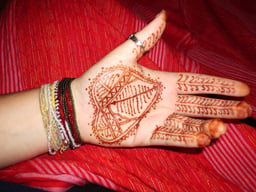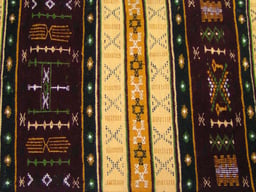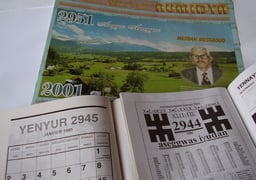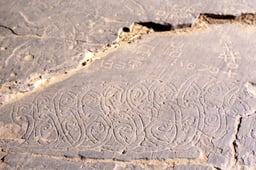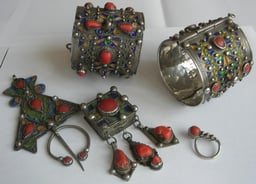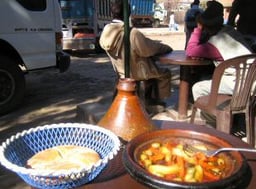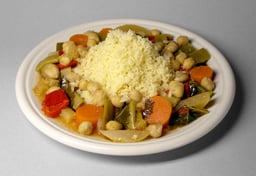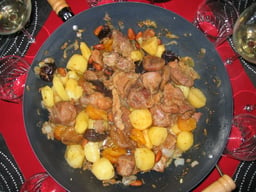Berbers
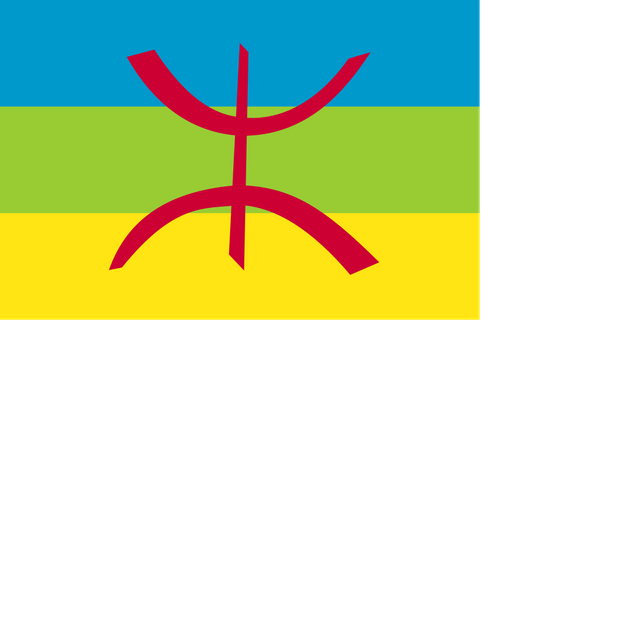
Berbers

| Total population | |
|---|---|
| 20–30 million[1][2][3]– 50 million[4] | |
| Regions with significant populations | |
| Morocco | from ≈ 10 million[2]to ≈ 12 million[5][6][7] |
| Algeria | from 9[2]to ≈ 13 million[7][8] |
| Libya | ~3,850,000[4] |
| Tunisia | 110,000[9]to ≈ 389,652[4] |
| France | more than 2 million[10] |
| Mauritania | 2,883,000 (2,768,000[11]& 115,000[12]) |
| Niger | 1,620,000[13] |
| Mali | 850,000[14] |
| Belgium | 500,000(Including descendants)[15] |
| Netherlands | 367,455(Including descendants) |
| Burkina Faso | 50,000[16] |
| Egypt | 34,000[17]or 1,826,580[4] |
| Canada | 37,060 (Including those of mixed ancestry)[18] |
| Israel | 3,500[19] |
| United States | 1,327[20] |
| Languages | |
| Berber languages(Tamazight), traditionally written withTifinaghalphabet, alsoBerber Latin alphabet;Maghrebi Arabicdialects (amongArabized Berbers) | |
| Religion | |
| PredominantlySunni Islam.Minorities adhere to other Islamic denominations (Shia,Ibadi),Christianity(chieflyProtestantism),[21][22]Judaism, andtraditional faith | |
| Related ethnic groups | |
| other Afro-Asiatic peoples[23][24][25][26][27][28][29] | |

Flag of the Berber nation the Kingdom of Ait Abbas prior to modern day Algeria until 1872.

The Kabyle people are Berber people indigenous to Algeria.
Berbers constitute the populations of Morocco, Algeria, Tunisia, Libya, Mauritania, northern Mali, northern Niger, and a small part of western Egypt.
Berber nations are distributed over an area stretching from the Atlantic Ocean to the Siwa Oasis in Egypt and from the Mediterranean Sea to the Niger River in West Africa. Historically, Berber nations spoke the Berber language, which is a branch of the Afroasiatic language family. The Berbers of Algeria were independent of outside control during the period of Ottoman Empire rule in North Africa. They lived primarily in three different Nations: the Kingdom of Ait Abbas, Kingdom of Kuku, and the principality of Aït Jubar.[40] Kingdom of Ait Abbas is a Berber nation of North Africa, controlling Lesser Kabylie and its surroundings from the sixteenth century to the nineteenth century. It is referred to in the Spanish historiography as "reino de Labes";[41] sometimes more commonly referred to by its ruling family, the Mokrani, in Berber At Muqran, in Arabic أولاد مقران (Ouled Moqrane). Its capital was the Kalâa of Ait Abbas, an impregnable citadel in the Biban mountain range.
There are about 32 million Berbers in North Africa who still speak the Berber language.[3] The number of ethnic Berbers (including non-Berber speakers) is far greater than the speakers of the Berber language, as a large part of the Berbers have lost their ancestral language and created then switched to Maghrebi Arabic over the course of many decades or centuries.
The majority of North Africa's population west of Egypt is believed to be Berber in ethnic origin, although due to Arabization and Islamization some ethnic Berbers identify as Arabized Berbers.
Most Berber people who speak Berber today live in Morocco, Algeria, Libya, Tunisia, northern Mali, and northern Niger.[4] Smaller Berber-speaking populations are also found in Mauritania, Burkina Faso and Egypt's Siwa town.
The majority of Berbers are Sunni Muslim. The Berber identity is usually wider than language and ethnicity and encompasses the entire history and geography of North Africa. Berbers are a heterogenous ethnolinguistic group[30], and they encompass a range of societies, ancestries and lifestyles. Berbers call themselves some variant of the word i-Mazigh-en (singular: a-Mazigh), possibly meaning "free people" or "noble men".[42] The name probably had its ancient parallel in the Roman and Greek names for Berbers such as Mazices.[45]
| Total population | |
|---|---|
| 20–30 million[1][2][3]– 50 million[4] | |
| Regions with significant populations | |
| Morocco | from ≈ 10 million[2]to ≈ 12 million[5][6][7] |
| Algeria | from 9[2]to ≈ 13 million[7][8] |
| Libya | ~3,850,000[4] |
| Tunisia | 110,000[9]to ≈ 389,652[4] |
| France | more than 2 million[10] |
| Mauritania | 2,883,000 (2,768,000[11]& 115,000[12]) |
| Niger | 1,620,000[13] |
| Mali | 850,000[14] |
| Belgium | 500,000(Including descendants)[15] |
| Netherlands | 367,455(Including descendants) |
| Burkina Faso | 50,000[16] |
| Egypt | 34,000[17]or 1,826,580[4] |
| Canada | 37,060 (Including those of mixed ancestry)[18] |
| Israel | 3,500[19] |
| United States | 1,327[20] |
| Languages | |
| Berber languages(Tamazight), traditionally written withTifinaghalphabet, alsoBerber Latin alphabet;Maghrebi Arabicdialects (amongArabized Berbers) | |
| Religion | |
| PredominantlySunni Islam.Minorities adhere to other Islamic denominations (Shia,Ibadi),Christianity(chieflyProtestantism),[21][22]Judaism, andtraditional faith | |
| Related ethnic groups | |
| other Afro-Asiatic peoples[23][24][25][26][27][28][29] | |
Name
The term Berber is a variation of the Greek original word barbaros ("barbarian"), earlier in history applied by Romans specifically to their northern hostile neighbors from Germania (modern Germany) and Celts, Iberians, Gauls, Goths and Thracians.
Among its oldest written attestations, Berber appears as an ethnonym in the 1st century AD Periplus of the Erythraean Sea.[46]
Despite these early manuscripts, certain modern scholars have argued that the term only emerged around 900 AD in the writings of Arab genealogists,[47] with Maurice Lenoir positing an 8th or 9th century date of appearance.[48] The English term was introduced in the 19th century, replacing the earlier Barbary
The Berbers are the Mauri cited by the Chronicle of 754 during the Umayyad conquest of Hispania, to become since the 11th century the catch-all term Moros (in Spanish; Moors in English) on the charters and chronicles of the expanding Christian Iberian kingdoms to refer to the Andalusi, the north Africans, and the Muslims overall.
For the historian Abraham Isaac Laredo[49] the name Amazigh could be derived from the name of the ancestor Mezeg which is the translation of biblical ancestor Dedan son of Sheba in the Targum. According to Leo Africanus, Amazigh meant "free man", some argued that there is no root of M-Z-Ɣ meaning "free" in modern Berber languages. However, mmuzeɣ "to be noble, generous" exist among the Imazighen of Central Morocco and tmuzeɣ "to free oneself, revolt" among the Kabyles of Ouadhia.[50] This dispute, however, is based on a lack of understanding of the Berber language as "Am-" is a prefix meaning "a man, one who is […]" Therefore, the root required to verify this endonym would be * (a)zigh*, "free", which however is also missing from Tamazight's lexicon, but may be related to the well attested aze "strong", Tizzit "bravery", or jeghegh "to be brave, to be courageous".[51]
Further, it also has a cognate in the Tuareg word Amajegh, meaning "noble".[52][53] This term is common in Morocco, especially among Central Atlas, Rifian and Shilah speakers in 1980,[54] but elsewhere within the Berber homeland sometimes a local, more particular term, such as Kabyle or Chaoui, is more often used instead in Algeria.[55]
The Egyptians, Greeks, Romans, and Byzantines mentioned various tribes with similar names living in Greater "Libya" (North Africa) in the areas where Berbers were later found.
Later tribal names differ from the classical sources, but are probably still related to the modern Amazigh. The Meshwesh tribe among them represents the first thus identified from the field. Scholars believe it would be the same tribe called a few centuries afterwards in Greek as Mazyes by Hektaios and as Maxyes by Herodotus, while it was called after that Mazaces and Mazax in Latin sources, and related to the later Massylii and Masaesyli. Late Antiquity Roman and Coptic sources also mention that Mazices (ⲙⲁⲥⲓⲅⲝ in Coptic)[56] conducted multiple raids against Egypt.[57] all those names are similar and perhaps foreign renditions of the name used by the Berbers in general for themselves, Imazighen.
Prehistory
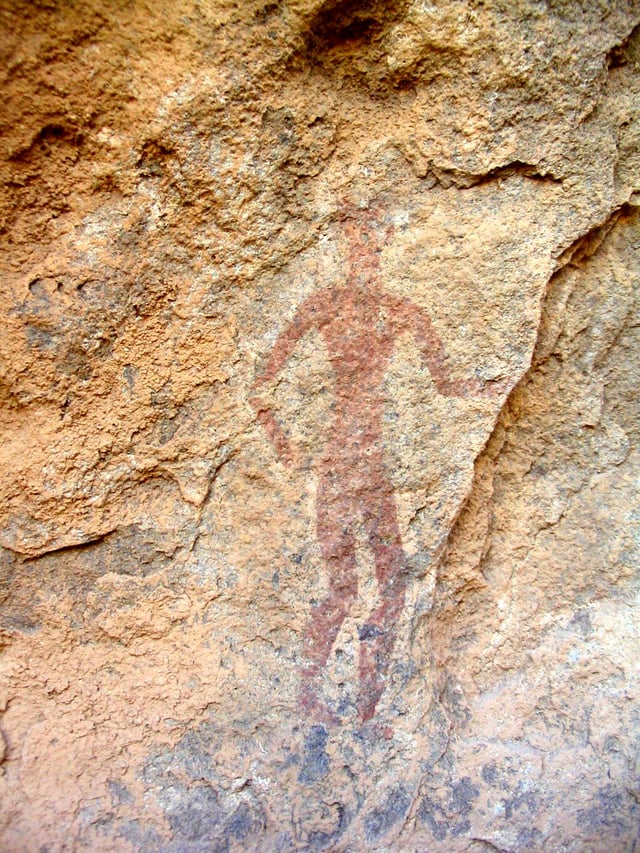
Hoggar painting, Tassili n'Ajjer

An Egyptian statuette representing a Libyan Libu Berber. Reign of Rameses II (19th Dynasty), 1279–1213 BCE. (Louvre Museum, Paris)
The Maghreb region in northwestern Africa is believed to have been inhabited by Berbers from at least 10,000 BC.[58] Local cave paintings, which have been dated to twelve millennia before present, have been found in the Tassili n'Ajjer region of southern Algeria. Other rock art has been observed in Tadrart Acacus in the Libyan desert. A Neolithic society, marked by domestication and subsistence agriculture, developed in the Saharan and Mediterranean region (the Maghreb) of northern Africa between 6000 and 2000 BC. This type of life, richly depicted in the Tassili n'Ajjer cave paintings of southeastern Algeria, predominated in the Maghreb until the classical period.
History
In historical times, the Berbers expanded south into the Sahara (displacing earlier populations such as the Azer and Bafour). Much of Berber culture is still celebrated among the cultural elite in Morocco and Algeria.
The areas of North Africa that have retained the Berber language and traditions best have been, in general, Morocco and the Hautes Plaines of Algeria (Kabylie, Aurès etc.), most of which in Roman and Ottoman times had remained largely independent. The Ottomans did penetrate the Kabylie area, and to places the Phoenicians never penetrated, far beyond the coast, where Turkish influence can be seen in food, clothes and music. These areas have been affected by some of the many invasions of North Africa, most recently that of the French.
Origins

A faience tile from the throne of Pharaoh Ramesses III depicting a tattooed ancient Libyan chief (ca. 1184 to 1153 BC).
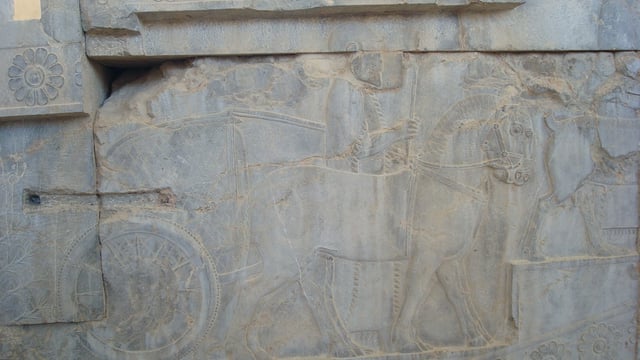
Ancient Libyan delegation at Persepolis.
Around 5000 BC, the populations of North Africa were primarily descended from the makers of the Iberomaurusian and Capsian cultures, with a more recent intrusion associated with the Neolithic Revolution.[63] The proto-Berber tribes evolved from these prehistoric communities during the Late Bronze to Early Iron Age.[64]
Uniparental DNA analysis has established ties between Berbers and other Afroasiatic speakers in Africa.
Most of these populations belong to the E1b1b paternal haplogroup, with Berber speakers having among the highest frequencies of this lineage.[65] Additionally, genomic analysis has found that Berber and other Maghreb communities are defined by a shared ancestral component. This Maghrebi element peaks among Tunisian Berbers.[66] It is related to the Coptic/Ethio-Somali, having diverged from these and other West Eurasian-affiliated components prior to the Holocene.[67]
In 2013, Iberomaurusian skeletons from the prehistoric sites of Taforalt and Afalou in the Maghreb were also analyzed for ancient DNA. All of the specimens belonged to maternal clades associated with either North Africa or the northern and southern Mediterranean littoral, indicating gene flow between these areas since the Epipaleolithic.[68] The ancient Taforalt individuals carried the mtDNA haplogroups U6, H, JT and V, which points to population continuity in the region dating from the Iberomaurusian period.[69]
Human fossils excavated at the Ifri n'Amr or Moussa site in Morocco have been radiocarbon-dated to the Early Neolithic period, ca. 5,000 BC. Ancient DNA analysis of these specimens indicates that they carried paternal haplotypes related to the E1b1b1b1a (E-M81) subclade and the maternal haplogroups U6a and M1, all of which are frequent among present-day communities in the Maghreb. These ancient individuals also bore an autochthonous Maghrebi genomic component that peaks among modern Berbers, indicating that they were ancestral to populations in the area. Additionally, fossils excavated at the Kelif el Boroud site near Rabat were found to carry the broadly-distributed paternal haplogroup T-M184 as well as the maternal haplogroups K1, T2 and X2, the latter of which were common mtDNA lineages in Neolithic Europe and Anatolia. These ancient individuals likewise bore the Berber-associated Maghrebi genomic component. This altogether indicates that the Late Neolithic Kelif el Boroud inhabitants were ancestral to contemporary populations in the area, but also likely experienced gene flow from Europe.[70]
Antiquity

Heracles wrestling with the Libyan giant Antaeus

Berber Kingdoms in Numidia, c. 220 BC (green: Masaesyli under Syphax; gold: Massyli under Gala, father of Masinissa; further east: city-state of Carthage).
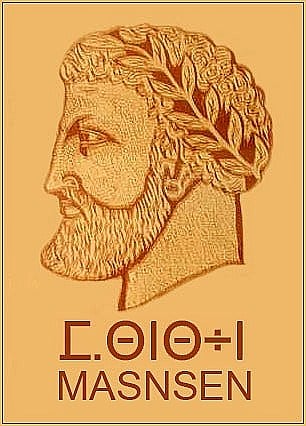
Masinissa (c. 240–148), King of Numidia, Berber and Roman script
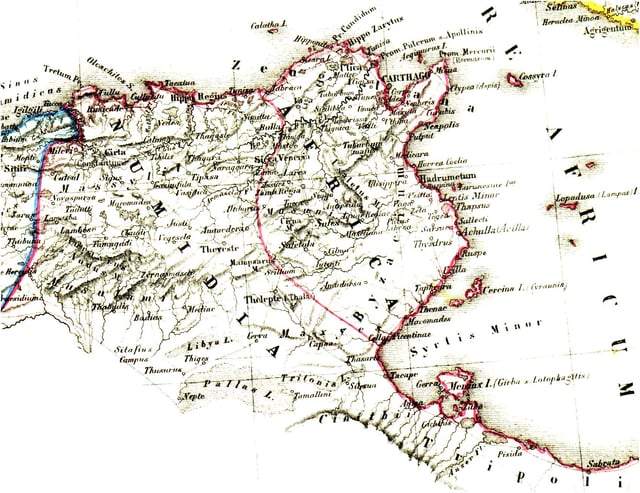
A map of Numidia
The grand tribal identities of Berber antiquity (then often known as ancient Libyans)[71] were said to be three (roughly, from west to east): the Mauri, the Numidians near Carthage, and the Gaetulians. The Mauri inhabited the far west (ancient Mauretania, now Morocco and central Algeria). The Numidians occupied the regions between the Mauri and the city-state of Carthage. Both the Numidians and the Mauri had significant sedentary populations living in villages, and their peoples both tilled the land and tended herds. The Gaetulians were less settled, with predominantly pastoral elements, and lived in the near south on the margins of the Sahara.[72][73][74]
For their part, the Phoenicians (Canaanites) came from the perhaps most advanced multicultural sphere then existing, the western coast of the Fertile Crescent. Accordingly, the material culture of Phoenicia was likely more functional and efficient, and their knowledge more explanatory, than that of the early Berbers. Hence, the interactions between Berbers and Phoenicians were often asymmetrical. The Phoenicians worked to keep their cultural cohesion and ethnic solidarity, and continuously refreshed their close connection with Tyre, the mother city.[75]
The earliest Phoenician landing stations located on the coasts were probably meant merely to resupply and service ships bound for the lucrative metals trade with the Iberian peninsula.[76] Perhaps these newly arrived sea traders were not at first particularly interested in doing much business with the Berbers, for reason of the little profit regarding the goods the Berbers had to offer.[77] The Phoenicians established strategic colonial cities in many Berber areas, including sites outside of present-day Tunisia, e.g., the settlements at Oea, Leptis Magna, Sabratha (in Libya), and Volubilis, Chellah and Mogador (now in Morocco). As in Tunisia these centres were trading hubs, and later offered support for resource development such as olive oil at Volubilis and Tyrian purple dye at Mogador. For their part, most Berbers maintained their independence as farmers or semi-pastorals although, due to the exemplar of Carthage, their organized politics increased in scope and acquired sophistication.[78]
In fact for a time their numerical and military superiority (the best horse riders of that time) enabled some Berber kingdoms to impose a tribute payable by Carthage, a condition that continued into the 5th century BC.[76][80] le). Correspondingly, in early Carthage careful attention was given to securing the most favorable treaties with the Berber chieftains, "which included intermarriage between them and the Punic aristocracy."[81] In this regard, perhaps the legend about Dido, the foundress of Carthage, as related by Trogus is apposite. Her refusal to wed the Mauritani chieftain Hiarbus might be indicative of the complexity of the politics involved.[82]
Eventually the Phoenician trading stations would evolve into permanent settlements, and later into small towns, which would presumably require a wide variety of goods as well as sources of food, which could be satisfied in trade with the Berbers.
Yet here too, the Phoenicians probably would be drawn into organizing and directing such local trade, and also into managing agricultural production.
In the 5th century BC, Carthage expanded its territory, acquiring Cape Bon and the fertile Wadi Majardah,[83] later establishing its control over productive farm lands within several hundred kilometers.[84] Appropriation of such wealth in land by the Phoenicians would surely inspire some resistance by the Berbers, although in warfare, too, the technical training, social organization, and weaponry of the Phoenicians would seem to work against the tribal Berbers. This social-cultural interaction in early Carthage has been summarily described:
Lack of contemporary written records make the drawing of conclusions here uncertain, which can only be based on inference and reasonable conjecture about matters of social nuance.
Yet it appears that the Phoenicians generally did not interact with the Berbers as economic equals, but employed their agricultural labor, and their household services, whether by hire or indenture; many became sharecroppers.[85] For a period the Berbers were in constant revolt. In 396 there was a great uprising. "Thousands of rebels streamed down from the mountains and invaded Punic territory, carrying the serfs of the countryside along with them. The Carthaginians were obliged to withdraw within their walls and were besieged." Yet the Berbers lacked cohesion, and although 200,000 strong at one point they succumbed to hunger; their leaders were offered bribes; "they gradually broke up and returned to their homes."[76]The%20Life%20and%20Death%20of%20Carthage]]Thereafter, "a series of revolts took place among the Libyans [Berbers] from the fourth century onwards."[[87]](https://openlibrary.org/search?q=Warmington%2C%20 [[CITE|87|https://openlibrary.org/search?q=Warmington%2C%20Carthage%20%281960%2C%202d%20ed.%201969%29%2C%20p.%2081.)
The Berbers had become involuntary 'hosts' to the settlers from the east, and obliged to accept the Punic dominance of Carthage for many centuries. The Berbers belonged to the lower social class when in Punic society. Nonetheless, therein they persisted largely unassimilated, as a separate, submerged entity, as a culture of mostly passive urban and rural poor within the civil structures created by Punic rule.[88] In addition, and most importantly, the Berber peoples also formed quasi-independent satellite societies along the steppes of the frontier and beyond, where a minority continued as free 'tribal republics'. While benefiting from Punic material culture and political-military institutions, these peripheral Berbers (also called Libyans) maintained their own identity, culture and traditions, continued to develop their own agricultural and village skills, while living with the newcomers from the east in an asymmetric symbiosis.[89][90]
As the centuries passed there naturally grew a Punic society of Phoenician-descent but born in Africa, called Libyphoenicians. This term later came to be applied also to Berbers acculturated to urban Phoenician culture.[91] Yet the whole notion of a Berber apprenticeship to the Punic civilization has been called an exaggeration sustained by a point of view fundamentally foreign to the Berbers.[92] There evolved a population of mixed ancestry, Berber and Punic. There would develop recognized niches in which Berbers had proven their utility. For example, the Punic state began to field Berber Numidian cavalry under their commanders on a regular basis. The Berbers eventually were required to provide soldiers (at first "unlikely" paid "except in booty"), which by the fourth century BC became "the largest single element in the Carthaginian army".[93]
Yet in times of stress at Carthage, when a foreign force might be pushing against the city-state, some Berbers would see it as an opportunity to advance their interests, given their otherwise low status in Punic society.
Thus, when the Greeks under Agathocles (361–289 BC) of Sicily landed at Cape Bon and threatened Carthage (in 310 BC), there were Berbers under Ailymas who went over to the invading Greeks.[76] Also, during the long Second Punic War (218–201 BC) with Rome (see below), the Berber King Masinissa (c. 240–148 BC) joined with the invading Roman general Scipio, resulting to the war-ending defeat of Carthage at Zama, despite the presence of their renowned general Hannibal; on the other hand, the Berber King Syphax (d. 202 BC) had supported Carthage. The Romans too read these cues, so that they cultivated their Berber alliances and, subsequently, favored the Berbers who advanced their interests following the Roman victory.[95]
Carthage was faulted by her ancient rivals for the "harsh treatment of her subjects" as well as for "greed and cruelty".[96][97] Her Libyan Berber sharecroppers, for example, were required to pay one-half of their crops as tribute to the city-state during the emergency of the First Punic War. The normal exaction taken by Carthage was likely "an extremely burdonsome" one-quarter.[93] Carthage once famously attempted to short its Libyan and foreign soldiers, leading to the Mercenary revolt (240–237 BC).[99][100][101] Also the city-state seemed to reward those leaders known to deal ruthlessly with its subject peoples. Hence the frequent Berber insurrections. Moderns fault Carthage for failure "to bind her subjects to herself, as Rome did" her Italians. Yet Rome and the Italians held far more in common perhaps than did Carthage and the Berbers. Nonetheless, a modern criticism tells us that the Carthaginians "did themselves a disservice" by failing to promote the common, shared quality of "life in a properly organized city" that inspires loyalty, particularly with regard to the Berbers.[102] Again, the tribute demanded by Carthage was onerous.[103]
The Punic relationship with the majority Berbers continued throughout the life of Carthage. The unequal development of material culture and social organization perhaps fated the relationship to be an uneasy one. A long-term cause of Punic instability, there was no melding of the peoples. It remained a source of stress and a point of weakness for Carthage. Yet there were degrees of convergence on several particulars, discoveries of mutual advantage, occasions of friendship, and family.[104]
The Berbers enter historicity gradually during the Roman era. Byzantine authors mention the Mazikes (Amazigh) as tribal people raiding the monasteries of Cyrenaica. Garamantia was a notable Berber kingdom that flourished in the Fezzan area of modern-day Libya, in the Sahara desert, between 400 BC and 600 AD.
Roman era Cyrenaica became a center of early Christianity. Some pre-Islamic Berbers were Christians[105] (there is a strong correlation between membership of the Donatist doctrine and being Berber, ascribed to its matching their culture as well as their alienation from the dominant Roman culture of the Catholic church),[106] some perhaps Jewish, and some adhered to their traditional polytheist religion. The Roman era authors Apuleius and St. Augustine were born in Numidia. As is true of three popes from the province: Pope Victor I served during the reign of Roman emperor Septimius Severus, who was a North African of Roman/Punic ancestry (perhaps with some Berber blood).[107]
Numidia

Mauretanian cavalry under Lusius Quietus fighting in the Dacian wars, from the Column of Trajan
Numidia (202 – 46 BC) was an ancient Berber kingdom in modern Algeria and part of Tunisia. It later alternated between being a Roman province and being a Roman client state. The polity was located on the eastern border of modern Algeria, bordered by the Roman province of Mauretania (in modern Algeria and Morocco) to the west, the Roman province of Africa (modern Tunisia) to the east, the Mediterranean to the north, and the Sahara Desert to the south. Its people were the Numidians.
The name Numidia was first applied by Polybius and other historians during the third century BC to indicate the territory west of Carthage, including the entire north of Algeria as far as the river Mulucha (Muluya), about 160 kilometres (100 mi) west of Oran. The Numidians were conceived of as two great groups: the Massylii in eastern Numidia, and the Masaesyli in the west. During the first part of the Second Punic War, the eastern Massylii under their king Gala were allied with Carthage, while the western Masaesyli under king Syphax were allied with Rome.
In 206 BC, the new king of the eastern Massylii, Masinissa, allied himself with Rome, and Syphax of the Masaesyli switched his allegiance to the Carthaginian side. At the end of the war, the victorious Romans gave all of Numidia to Masinissa of the Massylii. At the time of his death in 148 BC, Masinissa's territory extended from Mauretania to the boundary of the Carthaginian territory, and also south-east as far as Cyrenaica, so that Numidia entirely surrounded Carthage (Appian, Punica, 106) except towards the sea.
Masinissa was succeeded by his son Micipsa. When Micipsa died in 118 BC, he was succeeded jointly by his two sons Hiempsal I and Adherbal and Masinissa's illegitimate grandson, Jugurtha, of Berber origin, who was very popular among the Numidians. Hiempsal and Jugurtha quarreled immediately after the death of Micipsa. Jugurtha had Hiempsal killed, which led to open war with Adherbal.
After Jugurtha defeated him in open battle, Adherbal fled to Rome for help.
The Roman officials, allegedly due to bribes but perhaps more likely because of a desire to quickly end conflict in a profitable client kingdom, settled the fight by dividing Numidia into two parts.
Jugurtha was assigned the western half.
However, soon after conflict broke out again, leading to the Jugurthine War between Rome and Numidia.
Mauretania
In antiquity, Mauretania (3rd century BC – 44 BC) was an ancient Mauri Berber kingdom in modern Morocco and part of Algeria. It became a client state of the Roman empire in 33 BC, then a full Roman province after the death of its last king Ptolemy of Mauretania in AD, a member of the Ptolemaic dynasty.
Middle Ages
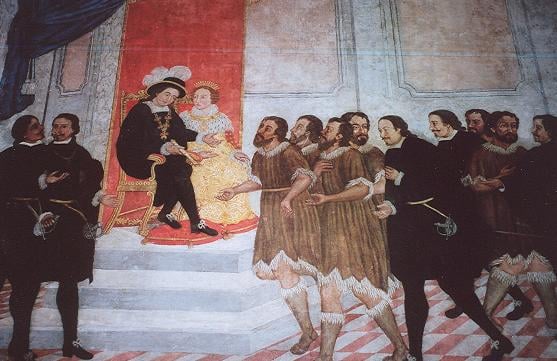
Fernández de Lugo presenting the captured Guanche kings of Tenerife to Ferdinand and Isabella, 1497
Before the eleventh century, most of North-West Africa was a Berber-speaking Muslim area.
The process of Arabization only became a major factor with the arrival of the Banu Hilal, a tribe sent by the Fatimids of Egypt to punish the Berber Zirid dynasty for having abandoned Shiism. The Banu Hilal reduced the Zirids to a few coastal towns and took over much of the plains; their influx was a major factor in the Arabization of the region and in the spread of nomadism in areas where agriculture had previously been dominant.
After the Muslim conquest, the Berber tribes of coastal North Africa became almost fully Islamized. Besides the Arabian influence, North African population also saw an influx via the Barbary Slave Trade of European peoples, with some estimates placing the number of European slaves brought to North Africa during the Ottoman period as high as 1.25 million.[108] Interactions with neighboring Sudanic empires, traders, and nomads from other parts of Africa also left impressions upon the Berber people.
According to historians of the Middle Ages, the Berbers were divided into two branches, Botr and Barnès, descended from Mazigh ancestors, who were themselves divided into tribes and subtribes.
Each region of the Maghreb contained several tribes (e.g. Sanhaja, Houaras, Zenata, Masmuda, Kutama, Awraba, Barghawata, and cetera). All these tribes had independence and territorial hegemony.[109][110]
Several Berber dynasties emerged during the Middle Ages in the Maghreb and al-Andalus.
The most notable are the Zirids (Ifriqiya, 973–1148), the Hammadids (Western Ifriqiya, 1014–1152), the Almoravid dynasty (Morocco and al-Andalus, 1050–1147), the Almohads (Morocco and al-Andalus, 1147–1248), the Hafsids (Ifriqiya, 1229–1574), the Zianids (Tlemcen, 1235–1556), the Marinids (Morocco, 1248–1465) and the Wattasids (Morocco, 1471–1554).
They belong to a powerful, formidable, brave and numerous people; a true people like so many others the world has seen – like the Arabs, the Persians, the Greeks and the Romans.
The men who belong to this family of peoples have inhabited the Maghreb since the beginning.— Ibn Khaldun, 14th century Tunisian historian[106]
Islamic conquest

Tlemcen, Patio of the Zianids
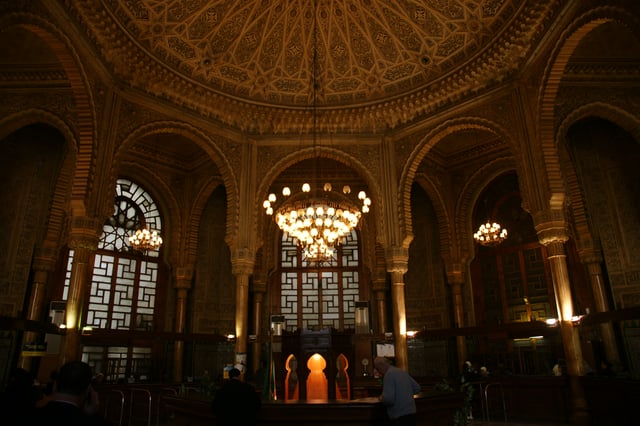
Berber architecture as seen in an Algiers building

A statue of Kahina, a seventh-century female Berber religious and military leader
Unlike the conquests of previous religions and cultures, the coming of Islam, which was spread by Arabs, was to have extensive and long-lasting effects on the Maghreb. The new faith, in its various forms, would penetrate nearly all segments of Berber society, bringing with it armies, learned men, and fervent mystics, and in large part replacing tribal practices and loyalties with new social norms and political idioms.
Nonetheless, the Islamization and Arabization of the region was a complicated and lengthy process. Whereas nomadic Berbers were quick to convert and assist the Arab conquerors, it was not until the twelfth century, under the Almohad Dynasty, that the Christian, Jewish, and animist communities of the Maghreb became marginalized.
Jews persisted within Northern Africa as dhimmis, protected peoples, under Islamic law. They continued to occupy prominent economic and political roles within the Maghreb.[111] Indeed, some scholars believe that Jewish merchants may have crossed the Sahara, although others dispute this claim. Indigenous Christian communities within the Maghreb all but disappeared under Islamic rule, although Christian communities from Europe may still be found in the Maghreb to this day. The indigenous Christian population in some Nefzaoua villages persisted until the 14th century.[112]
The first Arabian military expeditions into the Maghreb, between 642 and 669, resulted in the spread of Islam.
These early forays from a base in Egypt occurred under local initiative rather than under orders from the central caliphate. But when the seat of the caliphate moved from Medina to Damascus, the Umayyads (a Muslim dynasty ruling from 661 to 750) recognized that the strategic necessity of dominating the Mediterranean dictated a concerted military effort on the North African front. In 670, therefore, an Arab army under Uqba ibn Nafi established the town of Qayrawan about 160 kilometres south of modern Tunis and used it as a base for further operations.
Abu al-Muhajir Dinar, Uqba's successor, pushed westward into Algeria and eventually worked out a modus vivendi with Kusaila, the ruler of an extensive confederation of Christian Berbers. Kusaila, who had been based in Tlemcen, became a Muslim and moved his headquarters to Takirwan, near Al Qayrawan. This harmony was short-lived; Arabian and Berber forces controlled the region in turn until 697. By 711, Umayyad forces helped by Berber converts to Islam had conquered all of North Africa. Governors appointed by the Umayyad caliphs ruled from Kairouan, capital of the new wilaya (province) of Ifriqiya, which covered Tripolitania (the western part of modern Libya), Tunisia, and eastern Algeria.
The spread of Islam among the Berbers did not guarantee their support for the Arab-dominated caliphate due to the discriminatory attitude of the Arabs.
The ruling Arabs alienated the Berbers by taxing them heavily; treating converts as second-class Muslims; and, worst of all, by enslaving them.
As a result, widespread opposition took the form of open revolt in 739–40 under the banner of Ibadin Islam. The Ibadin had been fighting Umayyad rule in the East, and many Berbers were attracted by the sect's seemingly egalitarian precepts.
After the revolt, Ibadin established a number of theocratic tribal kingdoms, most of which had short and troubled histories.
But others, like Sijilmasa and Tlemcen, which straddled the principal trade routes, proved more viable and prospered. In 750, the Abbasids, who succeeded the Umayyads as Muslim rulers, moved the caliphate to Baghdad and reestablished caliphal authority in Ifriqiya, appointing Ibrahim ibn al Aghlab as governor in Kairouan. Though nominally serving at the caliph's pleasure, Al Aghlab and his successors, the Aghlabids, ruled independently until 909, presiding over a court that became a center for learning and culture.
Just to the west of Aghlabid lands, Abd ar Rahman ibn Rustam ruled most of the central Maghreb from Tahert, south-west of Algiers. The rulers of the Rustamid imamate (761–909), each an Ibadi imam, were elected by leading citizens. The imams gained a reputation for honesty, piety, and justice. The court at Tahert was noted for its support of scholarship in mathematics, astronomy, astrology, theology, and law. The Rustamid imams failed, by choice or by neglect, to organize a reliable standing army. This important factor, accompanied by the dynasty's eventual collapse into decadence, opened the way for Tahert's demise under the assault of the Fatimids. The Muslim Mahdia was founded by the Fatimids under the Caliph Abdallah al-Mahdi in 921 and made the capital city of Ifriqiya, by caliph Abdallah El Fatimi.[113] It was chosen as the capital because of its proximity to the sea, and the promontory on which an important military settlement had been since the time of the Phoenicians.[114]
The Fatimids established the Tunisian city of Mahdia and made it their capital city, before conquering Egypt, and building the city of Cairo in 969.
In al-Andalus under the Umayyad governors
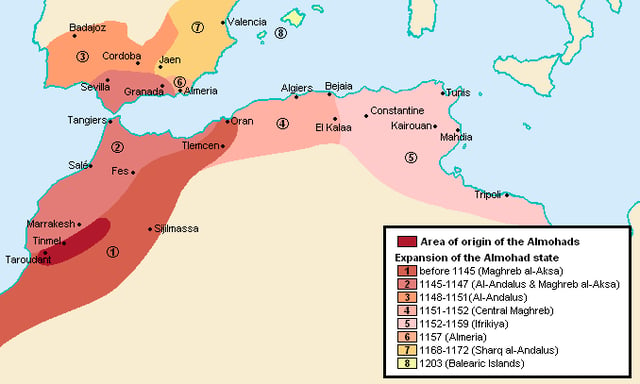
The Almohad Empire, a Berber empire that lasted from 1121 to 1269
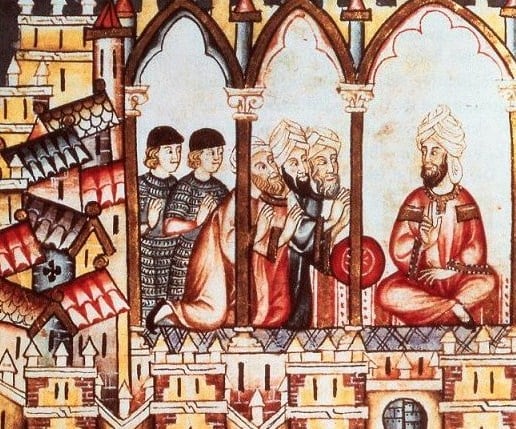
Castillian ambassadors meeting Almohad caliph Abu Hafs Umar al-Murtada, contemporary depiction from the Cantigas de Santa María
The Muslims who invaded the Iberian Peninsula in 711 were mainly Berbers, and were led by a Berber, Tariq ibn Ziyad, though under the suzerainty of the Arab Caliph of Damascus Abd al-Malik ibn Marwan and his North African Viceroy, Musa ibn Nusayr.[115] Due to subsequent antagonism between Arabs and Berbers, and to the fact that most of the histories of al-Andalus were written from an Arab perspective, the Berber role is understated in the available sources.[115] The biographical dictionary of Ibn Khallikan preserves the record of the Berber predominance in the invasion of 711, in the entry on Tariq ibn Ziyad.[115] A second mixed army of Arabs and Berbers came in 712 under Ibn Nusayr himself. They supposedly helped the Umayyad caliph Abd ar-Rahman I in al-Andalus, because his mother was a Berber.
Roger Collins suggests that if the forces that invaded the Iberian peninsula were predominantly Berber, it is because there were insufficient Arab forces in Africa to maintain control of Africa and attack Iberia at the same time.[115]Arab%20Conquest%20of%20Spain%2C%2071]]Thus, although north Africa had only been conquered about a dozen years previously, the Arabs already employed forces of the defeated Berbers to carry out their next invasion.[[117]](https://openlibrary.org/search?q=Collins%2C%20Roger%20%281994%29.%20 [[CITE|115|https://openlibrary.org/search?q=Collins%2C%20Roger%20%281994%29.%20*Arab%20Conquest%20of%20Spain%2C%2071) rber social organization made it possible for the Arabs to recruit entire tribal units into their armies, making the defeated Berbers excellent military auxiliaries.[115][119]
Governor As-Samh distributed land to the conquering forces, apparently by tribe, though it is difficult to determine from the few historical sources available.[115] It was at this time that the positions of Arabs and Berbers was regularized across the Iberian peninsula. Berbers were positioned in many of the most mountainous regions of Spain, such as the mountains of Granada, the Pyrenees, and the mountains of Cantabria and Galicia. Roger Collins suggests this may be because some Berbers were familiar with mountain terrain, whereas the Arabs were not.[115][115]Pelagius Asturias Galician and Cantabrian mountains, and by the middle of the eighth century it seems there was no more Berber presence in Galicia.[115] The expulsion of the Berber garrisons from central Asturias following the battle of Covadonga contributed to the eventual formation of the independent Asturian kingdom.[119]
Many Berbers were settled in what were then the frontier lands near Toledo, Talavera, and Merida.[115][115]Amrus ibn Yusuf Toledo the late 700s and early 800s.[115]Arab%20Conquest%20of%20Spain%2C%2071]]Berbers were also initially settled in the eastern Pyrenees and Catalonia.[[127]](https://openlibrary.org/search?q=Collins%2C%20Roger%20%281994%29.%20 [[CITE|115|https://openlibrary.org/search?q=Collins%2C%20Roger%20%281994%29.%20*Arab%20Conquest%20of%20Spain%2C%2071) doba.[115]
Roger Collins cites the work of Pierre Guichard to argue that Berber groups in Iberia retained their own distinctive social organization.[115]Arab%20Conquest%20of%20Spain%2C%2071]][130][131] eable to outside influences, whereas Arabs became assimilated and Hispanized.[115] Some support for the view that Berbers assimilated less comes from an excavation of an Islamic cemetery in northern Spain, which reveals that the Berbers accompanying the initial invasion brought their families with them from north Africa.[119]Caliphs%20and%20Kings%3A%20Spain%2C%20]][[132]](https://openlibrary.org/search?q=S%C3%A9nac%2C%20Philippe%20%282007%29.%20 [[CITE|132|https://openlibrary.org/search?q=S%C3%A9nac%2C%20Philippe%20%282007%29.%20Villes%20et%20campagnes%20de%20Ta)
In 731, the eastern Pyrenees were under the control of Berber forces garrisoned in the major towns under the command of Munnuza. Munnuza attempted to lead a Berber uprising against the Arabs in Spain, citing mistreatment of Berbers by Arabic judges in north Africa. Munnuza made an alliance with Duke Eudo of Aquitaine. However, governor Abd ar-Rahman attacked Munnuza before he was ready, and besieging him, defeated him at Cerdanya. Because of the alliance with Munnuza, Abd ar-Rahman wanted to punish Eudo, and his punitive expedition ended in the Arab defeat at Poitiers.[115]
By the time of the governor Uqba, and possibly as early as 714, the city of Pamplona was occupied by a Berber garrison.[115]Arab%20Conquest%20of%20Spain%2C%2071]]An eighth century cemetery has been discovered with 190 burials all according to Islamic custom, testifying to the presence of this garrison.[[134]](https://openlibrary.org/search?q=Collins%2C%20Roger%20%281994%29.%20 [[CITE|115|https://openlibrary.org/search?q=Collins%2C%20Roger%20%281994%29.%20*Arab%20Conquest%20of%20Spain%2C%2071)[132]Banu Qasi to a popular uprising. In 806 Pamplona gave allegiance to the Franks, and in 824 became an independent Kingdom of Pamplona. These events put an end to the Berber garrison in Pamplona.[115]
Al-Hakam wrote that there was a major Berber revolt in north Africa in 740–741, led by Masayra. The Chronicle of 754 calls these rebels Arures, which Collins translates as 'heretics', arguing it is a reference to the Berber rebels' Ibadi or Khariji sympathies.[115] After Charles Martel attacked Arab ally Maurontus at Marseille in 739, governor Uqba planned a punitive attack against the Franks, but news of a Berber revolt in north Africa made him turn back when he reached Zaragoza.[115] Instead, according to the Chronicle of 754, Uqba carried out an attack against Berber fortresses in Africa. Initially these attacks were unsuccessful, but then Uqba destroyed the rebels, secured all the crossing points to Spain, and then returned to his governorship.[115]
Although Masayra was killed by his own followers, the revolt spread and the Berber rebels defeated three Arab armies.[115] After the defeat of the third army, which included elite units of Syrians commanded by Kulthum and Balj, the Berber revolt spread further. At this time, the Berber military colonies in Spain revolted.[115] At the same time, Uqba died and was replaced by Ibn Qatan. By this time, the Berbers controlled most of the north of the Iberian peninsula, except for the Ebro valley, and were menacing Toledo. Ibn Qatan invited Balj and his Syrian troops, who were at that time in Ceuta, to cross to the Iberian peninsula to fight against the Berbers.[115]
The Berbers marched south in three columns, simultaneously attacking Toledo, Cordoba, and the ports on the Gibraltar Straits.
However, Ibn Qatan's sons defeated the army of Toledo, the governor's forces defeated the attack on Cordoba, and Balj defeated the attack on the straits.
After this, Balj seized power by marching on Cordoba and executing Ibn Qatan.[115] Collins points out that Balj's troops were away from Syria just when the Abbasid revolt against the Umayyads broke out, and this may have contributed to the fall of the Umayyad regime.[115]
In Africa, the Berbers acted under divided leadership.
Their attack on Kairouan was defeated, and a new governor of Africa, Hanzala ibn Safwan, proceeded to defeat the rebels in Africa and then to impose peace between Balj's troops and the existing Andalusi Arabs.[115]
Roger Collins argues that the Great Berber revolt facilitated the establishment of the Kingdom of Asturias and altered the demographics of the Berber population in the Iberian peninsula, specifically contributing to the Berber departure from the northwest of the peninsula.[115] When the Arabs first invaded the peninsula, Berber groups were situated in the northwest. However, due to the Berber revolt the Umayyad governors were forced to protect their southern flank and were unable to mount offenses against the Asturians. Some presence of Berbers in the northwest may have been maintained at first, but after the 740s there is no more mention of the northwestern Berbers in the sources.[115]
In al-Andalus during the Umayyad emirate
When the Umayyad dynasty was overthrown in 750, a grandson of Caliph Hisham, Abd ar-Rahman, escaped to north Africa.[115]Arab%20Conquest%20of%20Spain%2C%2071]]Abd ar-Rahman hid among the Berbers of north Africa for five years. A persistent tradition states that this is because his mother was Berber.[[148]](https://openlibrary.org/search?q=Collins%2C%20Roger%20%281994%29.%20 [[CITE|115|https://openlibrary.org/search?q=Collins%2C%20Roger%20%281994%29.%20*Arab%20Conquest%20of%20Spain%2C%2071)Ibn Habib then fled to the more powerful Zanata Berber confederacy, who were enemies of Ibn Habib. Since the Zanata had been part of the initial invasion force of al-Andalus, and were still present in the Iberian peninsula, this gave Abd ar-Rahman a base of support in al-Andalus.[115][115][119]
After Abd ar-Rahman crossed to Spain in 756, he declared himself the legitimate Umayyad ruler of al-Andalus.
The governor, Yusuf, refused to submit. After losing an initial battle near Cordoba,[115] Yusuf fled to Merida, where he raised a large Berber army. With this army, Yusuf marched on Seville, but was defeated by forces loyal to Abd ar-Rahman. Yusuf fled to Toledo, and was either killed on the way, or after reaching Toledo.[115]Arab%20Conquest%20of%20Spain%2C%2071]]However, Yusuf's cousin Hisham ibn Urwa continued to resist Abd ar-Rahman from Toledo until 764[[154]](https://openlibrary.org/search?q=Collins%2C%20Roger%20%281994%29.%20 [[CITE|115|https://openlibrary.org/search?q=Collins%2C%20Roger%20%281994%29.%20*Arab%20Conquest%20of%20Spain%2C%2071)Fihri tive at obtaining support from Berbers in their revolts against the Umayyad regime.[115]
As emir of al-Andalus, Abd ar-Rahman I faced persistent opposition from Berber groups, including the Zanata. Berbers provided much of Yusuf's support in fighting against Abd ar-Rahman. In 774 Zanata Berbers were involved in a Yemeni revolt in the area of Seville.[115][115]
In 768, a Miknasa Berber named Shaqya ibn Abd al-Walid declared himself a Fatimid imam, claiming descent from Fatimah and Ali.[115][115]Cuenca ous and challenging to traverse. Shaqya first killed the Umayyad governor of the fortress of Santaver (near Roman Ercavica), and subsequently ravaged the surrounding district of Coria. Abd ar-Rahman sent out armies to fight him in 769, 770, and 771, but Shaqya avoided them by moving into the mountains. In 772, Shaqya defeated an Umayyad force and killed the governor of the fortress of Medellin by a ruse. He was besieged by Umayyads in 774, but the revolt near Seville forced the besieging troops to withdraw. In 775 a Berber garrison in Coria declared allegiance to Shaqya, but Abd ar-Rahman retook the town and chased the Berbers into the mountains. In 776 Shaqya resisted sieges to his two main fortresses at Santaver and Shebat'ran (near Toledo). In 777 Shaqya was betrayed and killed by his own followers, who sent his head to Abd ar-Rahman.[115]
Roger Collins notes that both modern historians and ancient Arab authors have had a tendency to portray Shaqya as a fanatic followed by credulous fanatics, and to argue that he was either self-deluded or fraudulent in his claim of Fatimid descent.[115] However, Collins considers him an example of the messianic leaders that were not uncommon among Berbers at that time and earlier. He compares Shaqya to Idris I, a descendant of Ali accepted by the Zanata Berbers, who founded the Idrisid dynasty in 788, and to Salih ibn Tarif, who ruled the Bargawata Berber in the 770s. He also compares these leaders to pre-Islamic leaders Kahina and Kosayla.[115]
In 788, Hisham succeeded Abd ar-Rahman as emir, but his brother Sulayman revolted. Sulayman fled to the Berber garrison of Valencia, where he held out for two years. Finally he came to terms with Hisham and went into exile in 790, together with other brothers of his who had rebelled with him.[115] In north Africa, Sulayman and his brothers forged alliances with local Berbers, especially the Kharijite ruler of Tahert. After the death of Hisham I and the accession of Al-Hakam, the brothers challenged Al-Hakam for the succession. Abd Allah crossed over to Valencia first in 796, calling on the allegiance of the same Berber garrison that sheltered Sulayman years earlier.[119] Crossing to al-Andalus in 798, Sulayman based himself in Elvira (now Granada), Ecija, and Jaen, apparently drawing support from the Berbers in these mountainous southern regions. Sulayman was defeated in battle in 800 and fled to the Berber stronghold in Merida, but was captured before reaching it and executed in Cordoba.[115]
In 797, the Berbers of Talavera played a major part in defeating a revolt against Al-Hakam I in Toledo.[119] A certain Ubayd Allah ibn Hamir rebelled in Toledo against Al-Hakam. Al-Hakam order Amrus ibn Yusuf to destroy the rebellion. Amrus was the commander of the Berbers in Talavera. Amrus negotiated in secret with the Banu Mahsa faction in Toledo, promising them the governorship if they betrayed ibn Hamir. The Banu Mahsa brought Ibn Hamir's head to Amrus in Talavera. However, there was a feud between the Banu Mahsa and the Berbers of Talavera. The Berbers of Talavera killed all the Banu Mahsa. Amrus sent the heads of the Banu Mahsa along with that of Ibn Hamir to Al-Hakam in Cordoba. The Toledo rebellion was sufficiently weakened that Amrus was able to enter Toledo and convince its inhabitants to submit.[119]
Roger Collins argues that unassimilated Berber garrisons in al-Andalus engaged in local vendettas and feuds, such as the conflict with the Banu Mahsa.[119] This was due to the limited power of the Umayyad emir's central authority. Collins states that "the Berbers, despite being fellow Muslims, were despised by those who claimed Arab descent."[119] As well as having feuds with Arab factions, the Berbers sometimes had major conflicts with the local communities where they were stationed. In 794, the Berber garrison of Tarragona massacred the inhabitants of the city. Tarragona was uninhabited for seven years until the Frankish conquest of Barcelona led to its reoccupation.[119]
In 829, one of the leaders of the Toledo rebellion of 797, Hashim al-Darrab, who had been kept under arrest in Cordoba, escaped, returned to Toledo, and started another rebellion.[119] From Toledo, Hashim attacked the Berber garrisons of Santaver and Talavera, precisely those that had been involved in suppressing the Toledo rebellion a generation earlier. Hashim gained control of Calatrava la Vieja, then a major fortress town, until 834. Hashim was killed in battle in 831, but his followers maintained the rebellion, and Berbers from Calatrava besieged Toledo in 835 and 836. The rebellion was finally ended in 837, when the emir's brother al-Walid became governor of Toledo.[119]
Throughout the ninth century, the Berber garrisons were one of the main military supports of the Umayyad regime.[119] Although they had caused numerous problems for Abd ar-Rahman I, Collins suggests that by the reign of Al-Hakam, the Berber conflicts with Arabs and native Iberians meant that Berbers could only look to the Umayyad regime for support and patronage, developing solid ties of loyalty to the emirs. However, they were also difficult to control, and by the end of the ninth century the Berber frontier garrisons disappear from the sources. Collins says this might be because they migrated back to north Africa or gradually assimilated.[119]
A Berber leader named H'abiba led a rebellion around Algeciras in 850.
Little is known of this rebellion other than its occurrence, and that it may have had a religious inspiration.[119]
Berber groups were involved in the rebellion of Umar ibn Hafsun from 880 to 915.[119] Ibn Hafsun rebelled in 880, was captured, then escaped in 883 to his base in Bobastro. There he formed an alliance with the Banu Rifa' tribe of Berbers, who had a stronghold in Alhama.[119]Caliphs%20and%20Kings%3A%20Spain%2C%20]]He then formed alliances with other local Berber clans, taking the towns of Osuna, Estepa, and Ecija in 889. He captured Jaen in 892.[[173]](https://openlibrary.org/search?q=Collins%2C%20Roger%20%282014%29.%20 [[CITE|119|https://openlibrary.org/search?q=Collins%2C%20Roger%20%282014%29.%20*Caliphs%20and%20Kings%3A%20Spain%2C%20)Abd ar-Rahman III[119]
In al-Andalus during the Umayyad caliphate

Old fortress at Calatrava la Vieja. The site was used during the Muslim period from about 785 until the fall of the Caliphate of Cordova.
New waves of Berber settlers arrived in al-Andalus in the 10th century, brought in as mercenaries by Abd ar-Rahman III to help him in his campaigns to recover Umayyad authority in areas that had thrown off allegiance to the Umayyads during the reigns of the previous emirs.[119]Caliphs%20and%20Kings%3A%20Spain%2C%20]]These new Berbers "lacked any familiarity with the pattern of relationships" that had existed in al-Andalus in the 700s and 800s;[[176]](https://openlibrary.org/search?q=Collins%2C%20Roger%20%282014%29.%20 [[CITE|119|https://openlibrary.org/search?q=Collins%2C%20Roger%20%282014%29.%20*Caliphs%20and%20Kings%3A%20Spain%2C%20)[119]
New frontier settlements were built for the Berber mercenaries who arrived in the 900s.
Written sources state that some of Abd ar-Rahman's new Berber mercenaries were placed in Calatrava, which was refortified.[119] Another Berber settlement called Vascos, west of Toledo, is not mentioned in the historical sources, but has been excavated archaeologically. It was a fortified town, had walls, and a separate fortress or alcazar. Two cemeteries have been discovered also. It was established in the 900s as a frontier town for Berbers, probably of the Nafza tribe. It was abandoned soon after the Castilian occupation of Toledo in 1085. The Berber inhabitants took all their possessions with them.[119]Caliphs%20and%20Kings%3A%20Spain%2C%20]][[179]](https://openlibrary.org/search?q=Izquierdo%20Bonito%2C%20Ricardo%20%281994%29.%20 [[CITE|179|https://openlibrary.org/search?q=Izquierdo%20Bonito%2C%20Ricardo%20%281994%29.%20*Excavaciones%20en)
In the 900s, the Umayyad caliphate faced a challenge from the Fatimids in North Africa. The Fatimid caliphate was founded by Ubayd Allah al-Mahdi Billah after his disciples gained a large following among the Kutama Berbers in what is today eastern Algeria and western Tunisia. After taking the city of Kairouan and overthrowing the Aghlabids in 909, the Mahdi Ubayd Allah declared himself caliph, which represented a direct challenge to the Umayyad's own claim to the caliphate.[119] The Fatimids gained overlordship over the Idrisids, then launched a conquest of the Maghreb. To counter the threat, the Umayyads crossed the straits to take over Ceuta in 931,[119] and actively formed alliances with Berber confederacies such as the Zanata and the Awraba. Rather than fighting each other directly, the competition of Fatimids and Umayyads played out as a competition for Berber allegiances. In turn, this provided a motivation for the further Islamic conversion of Berbers, many of whom, particularly farther south away from the Mediterranean, were still Christian and pagan.[119] In turn, this would contribute to the development of Almoravids and Almohads, which would have a major impact on al-Andalus and contribute to the end of the Umayyad caliphate.[119]
With the help of his new mercenary forces, which were mainly composed of recent Berber arrivals, Abd ar-Rahman launched a series of attacks on parts of the Iberian peninsula that had fallen away from Umayyad allegiance.
In the 920s he campaigned against the areas that rebelled under Umar ibn Hafsun and still refused to submit. These he submitted in the 920s. He conquered Merida in 928–929, Ceuta in 931, and Toledo in 932.[119] In 934 Abd ar-Rahman III began a campaign in the north against Ramiro II of Leon and Muhammad ibn Hashim al-Tujibi, the governor of Zaragoza. According to Ibn Hayyan, after inconclusively confronting al-Tujibi on the Ebro, Abd ar-Rahman briefly forced the Kingdom of Pamplona into submission, ravaged Castile and Alava, and met Ramiro II in an inconclusive battle.[119] From 935 to 937, Abd ar-Rahman confronted the Tujibids, defeating them in 937. In 939 Ramiro II defeated the combined Umayyad and Tujibid armies in the Battle of Simancas.[119]
Umayyad influence in western North Africa spread through diplomacy rather than conquest.[119] The Umayyads sought out alliances with various Berber confederacies. These would declare loyalty to the Umayyad caliphate in opposition to the Fatimids. The Umayyads would send gifts including embroidered silk ceremonial cloaks. During this time, mints in cities on the Moroccan coast (Fes, Sijilmasah, Sfax, and al-Nakur) occasionally issued coins with the names of Umayyad caliphs, showing the extent of Umayyad diplomatic influence.[119]Caliphs%20and%20Kings%3A%20Spain%2C%20]]The text of a letter of friendship from a Berber leader to the Umayyad caliph has been preserved in the work of 'Isa al-Razi.[[186]](https://openlibrary.org/search?q= [[CITE|186|https://openlibrary.org/search?q=*Anales%20Palatinos%20del%20Califa%20de%20C%C3%B3rdoba%20al-Hakam%20I)
During the reign of Abd ar-Rahman III tensions increased between the three distinct components of the Muslim community in al-Andalus: Berbers, Saqaliba, and those of Arab or mixed Arab and Gothic descent.[119] Following Abd ar-Rahman's proclamation of the new Umayyad caliphate in Cordoba, the Umayyads placed a great emphasis on the Umayyad membership of the Quraysh tribe.[119]Caliphs%20and%20Kings%3A%20Spain%2C%20]]This led to a fashion in Cordoba for claiming pure Arab ancestry as opposed to descent from freed slaves.[[189]](https://openlibrary.org/search?q=Collins%2C%20Roger%20%282014%29.%20 [[CITE|119|https://openlibrary.org/search?q=Collins%2C%20Roger%20%282014%29.%20*Caliphs%20and%20Kings%3A%20Spain%2C%20)Visigothic[119] e consciousness of ancestry was the revival of ethnic disparagement, directed in particular against the Berbers and the Saqaliba."[119]
When the Fatimids moved their capital to Egypt in 969, they left north Africa in charge of viceroys from the Zirid clan of Sanhaja Berbers, who were Fatimid loyalists and enemies of the Zanata.[119] The Zirids in turn divided their territories, assigning some to the Hammadid branch of the family to govern. The Hammadids became independent in 1014, with their capital at Qal'at Beni-Hammad. With the withdrawal of the Fatimids to Egypt, however, the rivalry with the Umayyads decreased.[119]
Al-Hakam II sent Muhammad Ibn Abi Amir to north Africa in 973–974 to act as qadi al qudat to the Berber groups that had accepted Umayyad authority. Ibn Abi Amir was treasurer of the household of the caliph's wife and children, director of the mint at Madinat al-Zahra, commander of the Cordoba police, and qadi of the frontier. During his time as qadi in north Africa, Ibn Abi Amir developed close ties with the North African Berbers.[119]
On the death of Al-Hakam II, the heir Hisham II was underage, and the position of hajib was occupied by a Berber named al-Mushafi. However, general Ghalib ibn Abd ar-Rahman and Muhammad Ibn Abi Amir formed an alliance, and in 978 they overthrew al-Mushafi and his sons and other family members, who had received offices. Al-Mushafi was imprisoned for five years before being killed, and his family was stripped of property and titles.[119]
In 980, Ibn Abi Amir fell out with his ally Ghalib, and a civil war began.[119]Caliphs%20and%20Kings%3A%20Spain%2C%20]]Ibn Abi Amir called on the Berbers he had lived with in 973–974 to come help him.[[195]](https://openlibrary.org/search?q=Collins%2C%20Roger%20%282014%29.%20 [[CITE|119|https://openlibrary.org/search?q=Collins%2C%20Roger%20%282014%29.%20*Caliphs%20and%20Kings%3A%20Spain%2C%20)Kingdom of Navarre several battles, in the last one of which Ghalib was killed, bringing the civil war to an end. Ibn Abi Amir then took on the name al-Mansur, 'the victorious', by which he is more commonly known.[119]
Employing large numbers of Berber and Saqaliba mercenaries, al-Mansur intitiated a series of highly successful attacks on the Christian portions of the peninsula.[119] Among the most memorable campaigns were the sack of Barcelona in 985, the destruction of Leon in 988, the capture of Count Garcia Fernandez of Castile in 995, and the sack of Santiago in 997.[119] Al-Mansur died in 1002. He was succeeded as hajib by his son, Abd al-Malik. In 1008, Abd al-Malik died and was succeeded as hajib by his half-brother, Abd ar-Rahman, known as Sanchuelo because his mother was Navarrese.[119] Meanwhile, Hisham II remained caliph, though this had become a ceremonial position.
Considerable resentment arose in Cordoba against the increasing numbers of Berbers brought from north Africa by al-Mansur and his children Abd al-Malik and Sanchuelo.[119] It was said that Sanchuelo ordered anyone attending his court to wear Berber turbans, which Roger Collins suggests may not have been true, but shows that hostile anti-Berber propaganda was being used to discredit the sons of al-Mansur. In 1009, Sanchuelo had himself proclaimed Hisham II's successor, and then went on military campaign. However, while he was away a revolt took place. Sanchuelo's palace was sacked and his support fell away. As he marched back to Cordoba his own Berber mercenaries abandoned him.[119] Knowing the strength of ill feeling against them in Cordoba, they thought Sanchuelo would be unable to protect them and so they went elsewhere in order to survive and secure their own interests.[119] Sanchuelo was left with only a few followers, and was captured and killed in 1009. Hisham II abdicated and was replaced by Muhammad II al-Mahdi.
Having abandoned Sanchuelo, the Berbers who had formed his army turned to another ambitious Umayyad, Sulayman, whom they supported.
They obtained logistical support from Count Sancho Garcia of Castile. Marching on Cordoba, they defeated Saqaliba general Wadih and forced Muhammad II al-Mahdi to flee to Toledo. They then installed Sulayman as caliph, and based themselves in the Madinat al-Zahra to avoid friction with the local population.[119] Wadih and al-Mahdi formed an alliance with the Counts of Barcelona and Urgell and marched back on Cordoba. They defeated Sulayman and the Berber forces in a battle near Cordoba in 1010. To avoid being destroyed, the Berbers left Cordoba and fled towards Algeciras.[119]
Al-Mahdi swore to exterminate the Berbers, and pursued them. However, he was defeated in battle near Marbella. With Wadih, he fled back to Cordoba while his Catalan allies went home. The Berbers turned around and besieged Cordoba. Deciding that he was about to lose, Wadih overthrew al-Mahdi and sent his head to the Berbers, replacing him with Hisham II.[119] However, the Berbers did not end the siege. They methodically destroyed Cordoba's suburbs, pinning the inhabitants inside the old Roman walls and destroying the Madinat al-Zahra. Wadih's allies killed him, and the Cordoba garrison surrendered with the expectation of amnesty. However, "a massacre ensued in which the Berbers took revenge for many personal and collective injuries and permanently settled several feuds in the process."[119] The Berbers made Sulayman caliph once again. Ibn Idhari said that the installation of Sulayman in 1013 was the moment when "the rule of the Berbers began in Cordoba and that of the Umayyads ended, after it had existed for two hundred and sixty eight years and forty-three days."[119]Caliphs%20and%20Kings%3A%20Spain%2C%20]][[204]](https://openlibrary.org/search?q=Ibn%20Idhari%20%281901%29.%20 [[CITE|204|https://openlibrary.org/search?q=Ibn%20Idhari%20%281901%29.%20*Histoire%20de%20l'Afrique%20du%20Nord%20)
In al-Andalus in the Taifa period
During the Taifa era, the petty kings came from a variety of ethnic groups; some—for instance the Zirid kings of Granada—were of Berber origin. The Taifa period ended when a Berber dynasty—the Moroccan Almoravids—took over al-Andalus; they were succeeded by the Almohad dynasty of Morocco, during which time al-Andalus flourished.
After the fall of Cordoba in 1013, the Saqaliba fled from the city to secure their own fiefdoms. One group of Saqaliba seized Orihuela from its Berber garrison and took control of its entire region.[119]
Among the Berbers who were brought to al-Andalus by al-Mansur were the Zirid family of Sanhaja Berbers. After the fall of Cordoba, the Zirids took over Granada in 1013, forming the Zirid kingdom of Granada. The Saqaliba Khayran, with his own Umayyad figurehead Abd ar-Rahman IV al-Murtada, attempted to seize Granada from the Zirids in 1018 but failed. Khayran then executed Abd ar-Rahman IV. Khayran's son, Zuhayr, also made war on the Zirid kingdom of Granada, but was killed in 1038.[119]
In Cordoba, conflicts continued between the Berber rulers and those of the citizenry who saw themselves as Arab.[119] After being installed as caliph with Berber support, Sulayman was pressured into distributing southern provinces to his Berber allies. The Sanhaja departed from Cordoba at this time. The Zanata Berber Hammudids received the important districts of Ceuta and Algeciras. The Hammudids claimed a family relation to the Idrisids, and thus traced their ancestry to the caliph Ali. In 1016 they rebelled in Ceuta, claiming to be supporting the restoration of Hisham II. They took control of Málaga, then marched on Cordoba, taking it and executing Sulayman and his family. Ali ibn Hammud al-Nasir declared himself caliph, a position he held for two years.[119]
For some years, Hammudids and Umayyads fought one another and the caliphate passed between them several times.
Hammudids also fought among themselves.
The last Hammudid caliph reigned until 1027.
The Hammudids were then expelled from Cordoba, where there was still a great deal of anti-Berber sentiment.
The Hammudids remained in Malaga until expelled by the Zirids in 1056.[119] The Zirids of Granada controlled Malaga until 1073, after which separate Zirid kings retained control over the taifas of Granada and Malaga until the Almoravid conquest.[208]
During the taifa period, the Aftasid dynasty based in Badajoz controlled a large territory centered on the Guadiana River valley.[208] The area of Aftasid control was very large, stretching from the Sierra Morena and the taifas of Mertola and Silves to the south, to the Campo de Calatrava in the west and the Montes de Toledo in the northwest and nearly as far as Oporto in the northeast.[208]
According to Bernard Reilly,[208] during the taifa period genealogy continued to be an obsession of the upper classes in al-Andalus. Most wanted to trace their lineage back to the Syrian and Yemeni Arabs who accompanied the invasion. In contrast, tracing descent from the Berbers who came with the same invasion "was to be stigmatized as of inferior birth."[208] Reilly notes, however, that in practice the two groups had by the 11th century become almost indistinguishable: "both groups gradually ceased to be distinguishable parts of the Muslim population, except when one of them actually ruled a taifa, in which case his origins were well publicized by his rivals. Nevertheless, distinctions between Arab, Berber, and slave were not the stuff of serious politics either within or between the taifas. It was the individual family that was the unit of political activity."[208] The Berber that arrived towards the end of the caliphate as mercenary forces, says Reilly, amounted to only about 20 thousand people in a total al-Andalusi population of six million. Their high visibility was due to their foundation of taifa dynasties rather than large numbers.[208]
In the power hierarchy, Berbers were situated between the Arabic aristocracy and the Muladi populace. Ethnic rivalry was one of the most important factors driving Andalusi politics. Berbers made up as much as 20% of the population of the occupied territory.[210] After the fall of the Caliphate, the Taifa kingdoms of Toledo, Badajoz, Málaga and Granada had Berber rulers. During the Reconquista, Berbers in the areas which became Christian kingdoms were acculturated and lost their ethnic identity, their descendants being among modern Spanish and Portuguese peoples.
In al-Andalus under the Almoravids

The Almoravid realm at its greatest extent, c. 1120
During the taifa period, the Almoravid empire developed in northwest Africa. The core of the Almoravid empire was formed by the Lamtuna branch of the Sanhaja Berber.[208] In the mid 11th century, they allied with the Guddala and Massufa Berber. At that time, the Almoravid leader Yahya ibn Ibrahim went on a hajj. On his way back he met Malikite preachers in Kairouan, and invited them to his land. Malikite disciple Abd Allah ibn Yasin accepted the invitation. Traveling to Morocco, he established a military monastery or ribat where he trained a highly motivated and disciplined fighting force. In 1054 and 1055, employing these specially trained forces, Almoravid leader Yahya ibn Umar defeated the Kingdom of Ghana and the Zanata Berber. After Yahya ibn Umar died, his brother Abu Bakr ibn Umar pursued the expansion of the Almoravids. Forced to resolve a Sanhaja civil war, he left control of the Moroccan conquests to his brother, Yusuf ibn Tashufin. Yusuf continued to conquer territory, and following Abu Bakr's death in 1087, Yusuf became the Almoravid leader.[208]
After their loss of Cordoba, the Hammudids had occupied Algeciras and Ceuta. In the mid-11th century, the Hammudids lost control of their Iberian possessions, but retained a small taifa kingdom based in Ceuta. In 1083, Yusuf ibn Tashufin conquered Ceuta. In the same year, al-Mutamid, king of the Sevilla taifa, traveled to Morocco to appeal to Yusuf for help against King Alfonso VI of Castile. Earlier, in 1079, the king of Badajoz, al-Mutawakkil, had appealed to Yusuf for help against Alfonso. After the fall of Toledo to Alfonso VI in 1085, al-Mutamid appealed again to Yusuf. This time, financed by the taifa kings of Iberia, Yusuf crossed to al-Andalus, taking direct personal control of Algeciras in 1086.[208]
Modern history

Berber village in the High Atlas mountains of Morocco

A Berberist flag
There is an identity-related debate about the persecution of Berbers by the Arab-dominated regimes of North Africa.
Through both exclusivities of Pan-Arabism and Islamism,[214] their issue of identity is due to the pan-Arabist ideology of the former Egyptian president, Gamal Abdel Nasser. Some activists have claimed that "It is time—long past overdue—to confront the racist arabization of the Amazigh lands."[214]
Soon after independence in the middle of the twentieth century, the countries of North Africa established Arabic as their official language, replacing French, Spanish and Italian; although the shift from European colonial languages to Arabic for official purposes continues even to this day. As a result, most Berbers had to study and know Arabic, and had no opportunities until the twenty-first century to use their mother tongue at school or university. This may have accelerated the existing process of Arabization of Berbers, especially in already bilingual areas, such as among the Chaouis of Algeria. Tamazight is now taught in Aures since the march led by Salim Yezza in 2004, which has started to the teaching of Tamazight in the schools in Aures.
While Berberism had its roots before the independence of these countries, it was limited to the Berber elite. It only began to gain success among the greater populace when North African states replaced their European colonial languages with Arabic and identified exclusively as Arabian nations, downplaying or ignoring the existence and the social specificity of Berbers. However, its distribution remains highly uneven. In response to its demands, Morocco and Algeria have both modified their policies, with Algeria redefining itself constitutionally as an "Arab, Berber, Muslim nation".
Now, Berber is a "national" language in Algeria and is taught in some Berber-speaking areas as a noncompulsory language.
In Morocco, after the constitutional reforms of 2011, Berber has become an official language, and is now taught as a compulsory language in all schools regardless of the area or the ethnicity.
Berbers have reached high positions in the social hierarchy across the Maghreb; good examples are the former president of Algeria, Liamine Zeroual, and the former prime minister of Morocco, Driss Jettou.
Nevertheless, Berberists who openly show their political orientations rarely reach high hierarchical positions. But, there are some exceptions; for example, Khalida Toumi, a feminist and Berberist militant, has been nominated as head of the Ministry of Communication in Algeria.
"In Libya, the Berbers were a key part of the rebel force that overthrew Moammar Gadhafi."[3] In the 2011 Libyan civil war, Berbers in the Nafusa Mountains were quick to revolt against the Gaddafi regime.[3] The mountains became a stronghold of the rebel movement, and were a focal point of the conflict, with much fighting occurring between rebels and loyalists for control of the region. "In Mali, the Tuareg, another Berber people, have armed themselves and are declaring a homeland in large swatches [sic, swathes] of the north."[3]
Contemporary demographics

Sanhaja Berber women in the 1970s
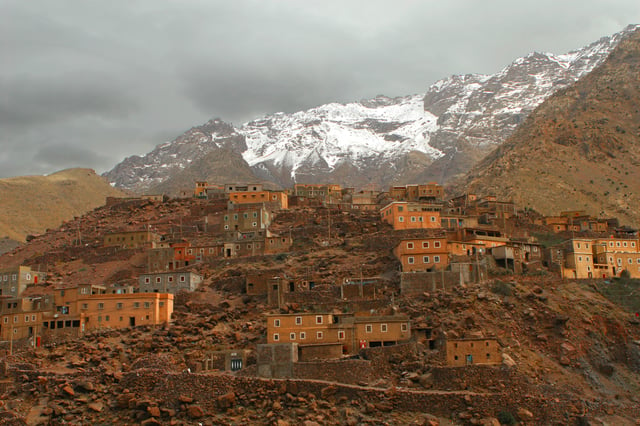
Berber village, Atlas mountains
The Maghreb today is home to large Berber (Amazigh) populations, who form the principal indigenous ancestry in the region (see Origins).[216][217][218][219][220][221][222][223][224][225] The Semitic ethnic presence in the region is mainly due to the Phoenicians, Jews and Arab Bedouin Hilallians migratory movements (third century BC and eleventh century, respectively) which mixed in. However, the majority of Arabized Berbers, particularly in Morocco and Algeria, claim an Arabian heritage; this is a consequence of the pan-Arab nationalism of the early twentieth century.
Outside the Maghreb, the Tuareg in Mali, Niger and Burkina Faso number some 850,000,[14] 1,620,000[13] and 50,000 respectively although Tuaregs are Berber people with a traditionally nomadic pastoralist lifestyle. They are the principal inhabitants of the vast Sahara Desert.[229][230]
Prominent Berber groups include the Kabyles from Kabylia, a historical autonomous region of northern Algeria, who number about six million and have kept, to a large degree, their original language and society; and the Shilha or Chleuh (French, from Arabic Shalh and Shilha ašəlḥi) in High and Anti-Atlas and Souss Valley of Morocco, numbering about eight million. Other groups include the Riffians of northern Morocco, the Chaoui people of eastern Algeria, the Chenouas in western Algeria, the Berbers of Tripolitania and the Tuaregs of the Sahara scattered through several countries.
Though stereotyped in Europe and North America as nomads, most Berbers were in fact traditionally farmers, living in mountains relatively close to the Mediterranean coast, or oasis dwellers, such as the Siwa of Egypt; but the Tuareg and Zenaga of the southern Sahara were almost wholly nomadic. Some groups, such as the Chaouis, practiced transhumance.
Political tensions have arisen between some Berber groups (especially the Kabyle) and North African governments over the past few decades, partly over linguistic and social issues; for instance, in Morocco, Algeria, Tunisia, and Libya, giving children Berber names was banned. The regime of Muammar Gaddafi in Libya also banned the teaching of Berber languages, and the leader warned Berber leaders in a 2008 diplomatic cable leaked by WikiLeaks "You can call yourselves whatever you want inside your homes – Berbers, Children of Satan, whatever – but you are only Libyans when you leave your homes."[231] As a result of the persecution suffered under Gaddafi's rule, many Berbers joined the Libyan opposition in the 2011 Libyan civil war.[232]
Diaspora
Berbers set up communities In Mauritania[233] near the Malian imperial capital of Timbuktu.[234] According to an estimate from 2004, there were about 2.2 million Berber immigrants in Europe, especially the Riffians in Belgium, the Netherlands and France and Algerians of Kabyles and Chaouis heritage in France.[235]
Languages
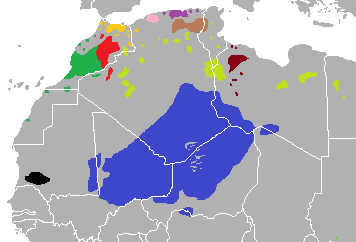
Areas in North Africa where Berber languages are spoken
The Berber languages form a branch of the Afro-Asiatic family. They thus descend from the proto-Afroasiatic language. It is still disputed which branches of Afroasiatic diverged most recently from Berber, but most linguists accept either Egyptian[236] or Chadic (see Afro-Asiatic languages).
Berber languages are spoken by around thirty to forty million people in Africa (see population estimation). These Berber speakers are mainly concentrated in Morocco and Algeria, followed by Mali, Niger and Libya. Smaller Berber-speaking communities are also found as far east as Egypt, with a southwestern limit today at Burkina Faso.
Tamazight is a generic name for all of the Berber languages. They consist of many closely related varieties/dialects. Among these Berber idioms are Riff, Kabyle, Shilha, Siwi, Zenaga, Sanhaja, Tazayit (Central Atlas Tamazight), Tumẓabt (Mozabite), Nafusi, and Tamasheq, as well as the ancient Guanche language.
Groups

Zinedine Zidane, born to Berber parents from Algeria (Kabyle; Berbers in France)
Although most people of the Maghreb share Berber ancestry, only some scattered groups succeeded in preserving Berber languages into modern times.
| Group | Country | Notes |
|---|---|---|
| Blida/Médéa Atlas Berbers | Algeria | in Central Algeria. |
| Chaoui people | Algeria | Found mainly in Eastern Algeria. |
| CheniniandDouiretBerbers | Tunisia | |
| Chenoui Berbers | Algeria | Ouarsenis and Mount Chenoua (Western Algeria). |
| Chleuhs | Morocco | the High Atlas, Anti-Atlas and the Sous valley. |
| Djerba Berbers | Tunisia | speakers of theDjerbi language. |
| Kabyles | Algeria | inKabylie. |
| Matmata Berbers | Tunisia | in Southern Tunisia. |
| Mozabites | Algeria | in theM'zabValley (southern Algeria). |
| Nafusis | Libya | in western Libya. |
| Riffians | Morocco | primarily in northern Morocco, with some also inAlgeria. |
| Sanhaja | Mauritania, Morocco and Senegal | in southwestern Mauritania, Middle Atlas mountains and eastern Morocco, and northern Senegal. |
| Siwi | Egypt | in theSiwavalley of Egypt. |
| TlemcenBerbers | Algeria | Aït Snouss villages of western Algeria. |
| Tuareg | Algeria, Libya,Niger, Mali, Burkina Faso | Sahara(southern Algeria and north of theSahel). |
| Zayanes | Morocco | Middle Atlas mountains of Morocco. |
| Zenatas | Morocco and Algeria | in northern and northeastern Morocco and western-central Algeria. |
| Zuwaras | Libya | in northwestern Libya. |
Religion

The mausoleum of Madghacen

Traditional Berber penannular brooch, a custom dating from the pre-Abrahamic era.
As a legacy of the spread of Islam, the Berbers are now mostly Sunni Muslim. The Mozabite Berbers of the Saharan Mozabite Valley and Libyan berbers in Nafusis and Zuwara are primarily adherents of the Ibadi Muslim denomination.
In antiquity, the Berber people adhered to the traditional Berber religion, prior to the arrival of Abrahamic faiths into North Africa. This traditional religion heavily emphasized ancestor veneration, polytheism and animism. Many ancient Berber beliefs were developed locally, whereas others were influenced over time through contact with other traditional African religions (such as the Ancient Egyptian religion), or borrowed during antiquity from the Punic religion, Judaism, Iberian mythology, and the Hellenistic religion. The most recent influence came from Islam and pre-Islamic Arab religion during the medieval period. Some of the ancient Berber beliefs still exist today subtly within the Berber popular culture and tradition.
Until the 1960s, there was also a significant Jewish Berber minority in Morocco,[237] but emigration (mostly to Israel and France) dramatically reduced their number to only a few hundred individuals.
Following Christian missions, the Kabyle community in Algeria has a decent-sized recently constituted Christian minority, both Protestant and Roman Catholic, and a 2015 study estimates 380,000 Muslim Algerians converted to Christianity in Algeria.[21] whereas among the 8,000[238]-40,000[239] Moroccans who have converted to Christianity in the last decades several Berbers are found; some of them explain their conversion as an attempt to go back to their "Christian sources".[240]
Notable Berbers
Some of the best known of the ancient Berbers are the Numidian king Masinissa, king Jugurtha, the Berber-Roman author Apuleius, Saint Augustine of Hippo, and the Berber-Roman general Lusius Quietus, who was instrumental in defeating the major wave of Jewish revolts of 115–117 in ancient Israel. The Berber queen Dihya, or Kahina, was a religious and political leader who led a military Berber resistance against the Arab-Muslim expansion in Northwest Africa. Kusaila was a 7th-century leader of the Berber Awerba tribe and King of the Iẓnagen confederation and resisted the Arab-Muslim invasion. Yusuf ibn Tashfin was a Muslim king of the Berber Almoravid dynasty. Abbas ibn Firnas was a Berber-Andalusian prolific inventor and early pioneer in aviation. Ibn Battuta was a medieval Berber explorer who departed from Tanja, Morocco and traveled the longest known distances of his time and chronicled his impressions of hundreds of nations and cultures.
In Christian history

Arius

Saint Augustine
Before the arrival of Islam into the region, most Berber groups were either Christian, Jewish or Animist, and a number of Berber theologians were important figures in the development of western Christianity.
In particular, the Berber Donatus Magnus was the founder of a Christian group known as the Donatists. The 4th-century Catholic Church viewed the donatists as heretics and the dispute led to a schism in the Church dividing North African Christians.[241] They are directly related to Circumcellions, a sect that worked on disseminating the doctrine in North Africa by the force of the sword.
Augustine of Hippo (Hippo being the modern Algerian city of Annaba), Scholars generally agree that Augustine and his family were Berbers, an ethnic group indigenous to North Africa,[242][243][244][245] but that they were heavily Romanized, speaking only Latin at home as a matter of pride and dignity. He is recognized as a saint and a Doctor of the Church by Roman Catholicism and the Anglican Communion and revered by the Reformed; he was an outspoken opponent of Donatism.[246]
Of all the fathers of the church, St. Augustine was the most admired and the most influential during the Middle Ages...
Augustine was an outsider—a native North African whose family was not Roman but Berber...
He was a genius—an intellectual giant.[247]
Many believe that Arius, another early Christian theologian who was deemed a heretic by the Christian Church, was of Libyan Berber descent. Another Berber cleric, Saint Adrian of Canterbury, traveled to England and played a significant role in its early medieval religious history.
Lusius Quietus, was the son of a Christian tribal lord from unconquered Mauretania (modern Morocco). Lusius' father and his warriors had supported the Roman legions in their attempt to subdue Mauretania Tingitana (northern modern Morocco) during Aedemon's revolt in 40.
Masuna (fl. 508) was a Romano-Moorish Christian king in Mauretania Caesariensis (western Algeria) who is said to have encouraged the Byzantine general Solomon, the Prefect of Africa, to launch an invasion of the Moorish kingdom of Numidia.[248]
Dihya was a Berber Christian religious and military leader who led indigenous resistance to Muslim conquest of the Maghreb, the region then known as Numidia, known as the Algeria today. She was born in the early seventh century and died around the end of the seventh century in modern Algeria. According to al-Mālikī she was said to have been accompanied in her travels by what the Arabs called an "idol", possibly an icon of the Virgin or one of the Christian saints.[249]
Quintus Septimius Florens Tertullianus (c. 155 – c. 240 AD), known as Tertullian (/tərˈtʌliən/), was a prolific early Christian author from Carthage in the Roman province of Africa and was the first Christian author to produce an extensive corpus of Latin Christian literature. He also was a notable early Christian apologist and a polemicist against heresy, including contemporary Christian Gnosticism. Tertullian has been called "the father of Latin Christianity" and "the founder of Western theology."
Sabellius, who was a third-century priest and theologian who most likely taught in Rome, may have been of African Berber descent. Basil and others call him a Libyan from Pentapolis, but this seems to rest on the fact that Pentapolis was a place where the teachings of Sabellius thrived, according to Dionysius of Alexandria, c. 260. What is known of Sabellius is drawn mostly from the polemical writings of his opponents.
Fadhma Aït Mansour, born in Tizi Hibel, Algeria, is the mother of writers Jean Amrouche and Taos Amrouche. Fadhma, the illegitimate daughter of a widow, was born in a Kabylie village. Later, when she was with the Sisters at Aït Manguellet hospital, she converted to Roman Catholicism. She met another Kabyle Catholic convert, Antoine-Belkacem Amrouche, whom she married in 1898.
Ahmed es-Sikeli, born in Djerba to a Berber family of the Sadwikish tribe was baptized a Christian under the name Peter, was a eunuch and kaid of the Diwan of the Kingdom of Sicily during the reign of William I. His story was recorded by his Christian contemporaries Romuald Guarna and Hugo Falcandus from Sicily and the Muslim historian Ibn Khaldun.[250]
Brother Rachid, a Moroccan Christian convert from Islam whose father is a well-known respected Imam. He is one of the most outspoken converts in the world, he hosts a weekly live call-in show on Al-Hayat channel where he compares Islam and Christianity as well as debating with Islamic scholars.
Malika Oufkir is a Moroccan writer and former "disappeared" person. She is the daughter of General Mohamed Oufkir and a cousin of fellow Moroccan writer and actress Leila Shenna. She and her siblings are converts from Islam to Catholicism, and she writes in her book, Stolen Lives: "we had rejected Islam, which had brought us nothing good, and opted for Catholicism instead."[251]
In Islamic history

Tariq ibn Ziyad, Berber Muslim and Umayyad general who led the conquest of Visigothic Hispania in 711
Tariq ibn Ziyad (died 720), known in Spanish history and legend as Taric el Tuerto (Taric the one-eyed), was a Berber Muslim and Umayyad general who led the conquest of Visigothic Hispania in 711. He is considered to be one of the most important military commanders in Spanish history. He was initially a servant of Musa ibn Nusair in North Africa, and was sent by his superior to launch the first thrust of an invasion of the Iberian peninsula. Some claim that he was invited to intervene by the heirs of the Visigothic King, Wittiza, in the Visigothic civil war.
On April 29, 711, the armies of Tariq landed at Gibraltar (the name Gibraltar is derived from the Arabic name Jabal Tariq, which means mountain of Tariq, or the more obvious Gibr Al-Tariq, meaning rock of Tariq). Upon landing, Tariq is said to have burned his ships then made the following speech, well known in the Muslim world, to his soldiers:
O People !
There is nowhere to run away!
The sea is behind you, and the enemy in front of you: There is nothing for you, by God, except only sincerity and patience.— as recounted by al-Maqqari
Ziri ibn Manad (died 971), founder of the Zirid dynasty in the Maghreb. Ziri ibn Manad was a clan leader of the Berber Sanhaja tribe who, as an ally of the Fatimids, defeated the rebellion of Abu Yazid (943–947). His reward was the governorship of the western provinces, an area that roughly corresponds with modern Algeria north of the Sahara.
Yusuf ibn Tashfin (c. 1061–1106) was the Berber Almoravid ruler in North Africa and Al-Andalus (Moorish Iberia). He took the title of amir al-muslimin (commander of the Muslims) after visiting the Caliph of Baghdad "amir al-Mu'minin" ("commander of the faithful") and officially receiving his support. He was either a cousin or nephew of Abu Bakr ibn Umar, the founder of the Almoravid dynasty. He united all of the Muslim dominions in the Iberian Peninsula (modern Portugal and Spain) to the Maghreb (c. 1090), after being called to the Al-Andalus by the Emir of Seville.
Alfonso VI was defeated on 23 October 1086, at the battle of Sagrajas, at the hands of Yusuf ibn Tashfin, and Abbad III al-Mu'tamid. Yusuf bin Tashfin is the founder of the famous Moroccan city Marrakech. He himself chose the place where it was built in 1070 and later made it the capital of his Empire. Until then, the Almoravids had been desert nomads, but the new capital marked their settling into a more urban way of life.
Ibn Tumart (c. 1080 – c. 1130), was a Berber religious teacher and leader from the Masmuda tribe who spiritually founded the Almohad dynasty. He is also known as El-Mahdi in reference to his prophesied redeeming. In 1125, he began an open revolt against Almoravid rule. The name "Ibn Tumart" comes from the Berber language and means "son of the earth."
Abu Ya'qub Yusuf (died on 29 July 1184) was the second Almohad caliph. He reigned from 1163 until 1184. He had the Giralda in Seville built.
Abu Yaqub al-Mustansir Yusuf II Caliph of Maghreb from 1213 until his death. The son of the previous caliph, Muhammad an-Nasir, Yusuf assumed the throne following his father's death, at the age of only 16 years.
Al-Busiri (1211–1294) was a Sanhaja Berber Sufi poet belonging to the Shadhiliyya order being direct disciple of Sheikh Abul Abbas al-Mursi.
Ibn Battuta (born 1304; year of death uncertain, possibly 1368 or 1377) was a Berber Sunni Islamic scholar and jurisprudent from the Maliki Madhhab (a school of Fiqh, or Islamic law), and at times a Qadi or judge.[252] However, he is best known as a traveler and explorer, whose account documents his travels and excursions over a period of almost thirty years, covering some 117,000 kilometres (73,000 mi). These journeys covered almost the entirety of the known Islamic realm, extending from modern West Africa to Pakistan, India, the Maldives, Sri Lanka, South-East Asia and China, a distance readily surpassing that of his predecessor, near-contemporary Marco Polo.
Muhammad al-Jazuli – From the tribe of Jazulah which was settled in the Sous area of Maghreb between the Atlantic Ocean and the Atlas Mountains. He is most famous for compiling the Dala'il al-Khayrat, an extremely popular Muslim prayer book.
Mohammed Awzal was a religious Berber poet. He is considered the most important author of the Shilha literary tradition. He was born around 1670 in the village of al-Qasaba in the region of Sous, Maghreb and died in 1748/9 (1162 of the Egira).
Averroes, a philosopher in the medieval period
Ibn Firnas, an aviation pioneer in the medieval period
Architecture
Culture
Traditionally, men take care of livestock. They migrate by following the natural cycle of grazing, and seeking water and shelter. They are thus assured with an abundance of wool, cotton and plants used for dyeing. For their part, women look after the family and handicrafts – first for their personal use, and secondly for sale in the souqs in their locality.
The Berber tribes traditionally weave kilims. The tapestry maintains the traditional appearance and distinctiveness of the region of origin of each tribe, which has in effect its own repertoire of drawings. The textile of plain weave is represented by a wide variety of stripes, and more rarely by geometrical patterns such as triangles and diamonds. Additional decorations such as sequins or fringes, are typical of Berber weave in Morocco. The nomadic and semi-nomadic lifestyle of the Berbers is very suitable for weaving kilims. The customs and traditions differ from one region to another.[253]
The social structure of the Berbers is tribal.
A leader is appointed to command the tribe.
In the Middle Ages, many women had the power to govern, such as Kahina and Tazoughert Fatma in the Aurès Mountains, Tin Hinan in the Hoggar, Chemci in Aït Iraten, Fatma Tazoughert in the Aurès. Lalla Fatma N'Soumer was a Berber woman in Kabylie who fought against the French.
The majority of Berber tribes currently have men as heads of the tribe.
In Algeria, the el Kseur platform in Kabylie gives tribes the right to fine criminal offenders. In areas of Chaoui, tribal leaders enact sanctions against criminals.[254] The Tuareg have a king who decides the fate of the tribe and is known as Amenokal. It is a very hierarchical society. The Mozabites are governed by the spiritual leaders of Ibadism. The Mozabites lead communal lives. During the crisis of Berriane, the heads of each tribe resolved the problem and began talks to end the crisis between the Maliki and Ibadite movements.[255]
In marriages, the man selects the woman, and depending on the tribe, the family often makes the decision.
In comparison, in the Tuareg culture, the woman chooses her future husband.
The rites of marriage are different for each tribe.
Families are either patriarchal or matriarchal, according to the tribe.
Cuisine
Berber cuisine is a traditional cuisine which has evolved little over time.
It differs from one area to another within and among Berber groups.
Principal Berber foods are:
Couscous, a semolina staple dish
Tajine, a stew made in various forms
Pastilla, a meat pie traditionally made with squab (fledgling pigeon) often today using chicken
Bread made with traditional yeast
Bouchiar (fine yeastless wafers soaked in butter and natural honey)
Bourjeje (pancake containing flour, eggs, yeast and salt)
Baghrir (light and spongy pancake made from flour, yeast, salt, served hot and soaked in butter and tment (honey).)
Tahricht (sheep offal: brains, tripe, lungs, and heart): these organ meats are rolled up with the intestines on an oak stick and cooked on embers in specially designed ovens. The meat is coated with butter to make it even tastier. This dish is served mainly at festivities.
Although they are the original inhabitants of North Africa, and in spite of numerous incursions by Phoenicians, Romans, Byzantines, Ottomans and French, Berber groups lived in very contained communities. Having been subject to limited external influences, these populations lived free from acculturating factors.
Music

The most common traditional music instruments

The fantasia festival, 19th-century illustration
Berber music, the traditional music of North Africa, has a wide variety of regional styles. The best known are the Moroccan music, the popular Gasba, Kabyle and Chawi music of Algeria, and the widespread Tuareg music of Burkina Faso, Niger, and Mali. The instruments used are the bendir (large drums) and Gambra (a lute), which accompanying songs and dances.
Traditional Kabyle music consists of vocalists accompanied by a rhythm section, consisting of e'ṯbel (tambourine) and bendir (frame drum), and a melody section, consisting of a ghaita (bagpipe) and ajouag (flute). Kabyle music has been popular in France since the 1930s, when it was played at cafés. As it evolved, Western string instruments and Arab musical conventions, like large backing orchestras, were added.
By the time raï, a style of Algerian popular music, became popular in France and elsewhere in Europe, Kabyle artists began using less traditional instruments and formats.
Hassen Zermani's all-electric Takfarinas (playing the Algerian mandole) and Abdelli's work with Peter Gabriel's Real World helped bring Kabyle music to new audiences, while the murder of Matoub Lounes inspired many Kabyles to rally around their popular musicians.
There are three varieties of Berber folk music: village and ritual music, and the music performed by professional musicians.
Village music is performed collectively for dancing, including ahidus and ahouach dances. Instruments include flutes and drums. These dances begin with a chanted prayer. Ritual music is performed at regular ceremonies to celebrate marriages and other important life events. Ritual music is also used as protection against evil spirits. Professional musicians (imdyazn) travel in groups of four, led by a poet (amydaz). The amydaz performs improvised poems, often accompanied by drums and rabab (a one-stringed fiddle), along with a bou oughanim who plays a double clarinet and acts as a clown for the group.
The Chleuh Berbers have professional musicians called rwais who play in ensembles consisting of lutes, rababs and cymbals, with any number of vocalist. The leader, or rayes, leads the choreography and music of the group. These performances begin with an instrumental astara on rabab, which also gives the notes of the melody which follows. The next phase is the amarg, or sung poetry, and then ammussu, a danced overture, tammust, an energetic song, aberdag, a dance, and finally the rhythmically swift tabbayt. There is some variation in the presentation of the order, but the astara always begins, and the tabbayt always ends.
Traditional Berber festivals include Fantasia. Imilchil Marriage Festival and Udayn n Acur.
See also
Arabized Berber
Berber languages
Traditional Berber religion
Berberism
Guanches, the indigenous Berber peoples of the Canary Islands.
Hamitic
List of Berber people
Tuareg
